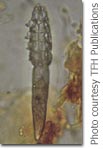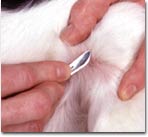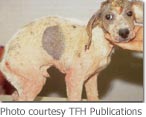|
Demodectic mange (also known as red mange, follicular mange, or puppy
mange) is a skin disease, generally of young dogs caused, by the mite, Demodex
canis. It may surprise you to know that this same mite lives,
without causing any harm or irritation, on the bodies of virtually every
adult dog and most human beings. These small (0.25 mm) "alligator-like"
mites live inside of the hair follicles (i.e., the pore within the skin
through which the hair shaft comes through), hence the name follicular
mange. In humans, the mites usually are found in the skin, eyelids and
the creases of the nose.

Whether or not Demodex causes harm to a dog depends on the animal's
ability to keep the mite under control. Demodectic mange is not a
disease of poorly kept or dirty kennels. It is generally a disease of
young dogs that have inadequate or poorly developed immune system or
older dogs that are suffering from a depressed immune system.
What is the life cycle of Demodex
canis?
The demodectic mite spends it's entire life on the dog. Eggs are laid by
a pregnant female, hatch, and then mature from larvae to nymphs to
adults. The life cycle is believed to take 20-35 days.
How is Demodex canis transmitted?
The mites are transferred directly from the mother to the puppies within
the first week of life. Transmission of the mites is by direct contact
only. That is, the mother and puppy must be physically touching, as the
parasite cannot survive off of the animal. This is important because it
means the kennel or bedding area does not become contaminated and
therefore the environment need not be treated. Lesions, if present,
usually appear first around the puppy's head, as this is the area most
in contact with the mother. Virtually every mother carries and transfers
mites to her puppies. Most puppies are immune to the mite's effects and
display no clinical signs or lesions. A few are not immune and it is
these that develop into full-blown cases of mange.
What are the signs of demodectic mange?
Individuals that are sensitive to the mange mites may develop a few
(less than 5) isolated lesions (localized mange) or they may have
generalized mange in which case there are more than 5 lesions involving
the entire body or region of the body. Most lesions in either form
develop after four months of age.
 The
lesions and signs of demodectic mange usually involve hair loss, crusty,
red skin and at times a greasy or moist appearance. The mites prefer to
live in the hair follicles, so in most cases hair loss is the first
noted sign. Usually hair loss begins around the muzzle, eyes and other
areas on the head. In localized mange, a few circular crusty areas will
be noted, most frequently around the muzzle. Most of these lesions will
self heal as the puppies become older and develop their own immunity.
Persistent lesions will need treatment that will be described later. In
cases in which the whole body is involved (generalized mange) there will
be areas of hair loss over the entire coat, including the head, neck,
abdomen, legs and feet. The skin along the head, side, and back will be
crusty and often times inflamed. It will often crack and ooze a clear
fluid. Hair will be scant, but the skin itself will often be oily to the
touch. Some animals can become quite ill and develop a fever, lose their
appetite and become lethargic. Patients with generalized demodectic
mange need immediate vigorous treatment. The
lesions and signs of demodectic mange usually involve hair loss, crusty,
red skin and at times a greasy or moist appearance. The mites prefer to
live in the hair follicles, so in most cases hair loss is the first
noted sign. Usually hair loss begins around the muzzle, eyes and other
areas on the head. In localized mange, a few circular crusty areas will
be noted, most frequently around the muzzle. Most of these lesions will
self heal as the puppies become older and develop their own immunity.
Persistent lesions will need treatment that will be described later. In
cases in which the whole body is involved (generalized mange) there will
be areas of hair loss over the entire coat, including the head, neck,
abdomen, legs and feet. The skin along the head, side, and back will be
crusty and often times inflamed. It will often crack and ooze a clear
fluid. Hair will be scant, but the skin itself will often be oily to the
touch. Some animals can become quite ill and develop a fever, lose their
appetite and become lethargic. Patients with generalized demodectic
mange need immediate vigorous treatment.
How is demodectic mange diagnosed?
 Once
Demodectic mange is suspected it can usually be confirmed by a skin
scraping or biopsy
in which the mites can be seen with the aid of a microscope. They are
too small to be seen with the naked eye. The adults appear as tiny
alligator-like mites. Remember that these mites are present in every dog
so by themselves they do not constitute a diagnosis of mange. The mite
must be coupled with the lesions for a diagnosis of mange to be made. Once
Demodectic mange is suspected it can usually be confirmed by a skin
scraping or biopsy
in which the mites can be seen with the aid of a microscope. They are
too small to be seen with the naked eye. The adults appear as tiny
alligator-like mites. Remember that these mites are present in every dog
so by themselves they do not constitute a diagnosis of mange. The mite
must be coupled with the lesions for a diagnosis of mange to be made.
How is demodectic mange treated?
The treatment of Demodectic mange is usually accomplished with lotions
dips and shampoos. Fortunately 90% of demodectic mange cases are
localized in which only a few small areas are involved and can often be
treated topically. A treatment that has been successful for years has
been a 1% retenone ointment (Goodwinol ointment) or more recently a 5%
benzoyl peroxide gel applied daily. Bathing periodically with a benzoyl
peroxide shampoo and feeding a high quality diet and a multi vitamin
with a fatty acid may also help some dogs. Most of these localized
lesions will heal on their own and do not require overly aggressive
treatment.
If a dog develops generalized demodicosis more aggressive treatment is
usually required. Studies show that between 30% and 50% of dogs that
develop the generalized form will recover on their own without treatment
but treatment is still always recommended for the generalized form. The
treatment of choice continues to be Amitraz dips applied every two
weeks. Amitraz is an organophosphate and is generally available under
the product name Mitaban. It is a prescription product and should be
applied with care. Humans should always wear rubber gloves when applying
it to their dog, and it should be applied in an area with adequate
ventilation. It is recommended that longhaired dogs be clipped short so
that the dip can make good contact with the skin. Prior to dipping, the
dog should be bathed with a benzoyl peroxide shampoo to help remove oil
and cellular debris.
 Most
dogs with generalized demodicosis require between 4 and 14 dips. After
the first three or four dips a skin scraping should be performed to
determine if the mites have been eliminated. Dips should continue until
there have been no mites found on the skin scrapings taken after 2
successive treatments. Some dogs develop sedation or nausea when dipped
and toy breeds in particular are sensitive to amitraz. Half strength
dips should be used on these sensitive animals. Most
dogs with generalized demodicosis require between 4 and 14 dips. After
the first three or four dips a skin scraping should be performed to
determine if the mites have been eliminated. Dips should continue until
there have been no mites found on the skin scrapings taken after 2
successive treatments. Some dogs develop sedation or nausea when dipped
and toy breeds in particular are sensitive to amitraz. Half strength
dips should be used on these sensitive animals.
|
Ivermectin should not be used in collies and similar breeds. |
Some dogs may not respond to this treatment and the frequency of the
dips may have to be increased or additional treatments may need to be
instituted. Recently, two new products have been used to help treat
demodicosis. These products are not FDA approved for the treatment of
demodectic mange, but are being widely used by veterinary dermatologists
and general practitioners with some good results. Ivermectin is a
broad-spectrum de-worming agent that is available in a 1% solution for
cattle. Ivermectin is the active ingredient in Heart Guard, however the
concentration in Heart Guard is not high enough to be effective against
Demodex. The liquid ivermectin is given daily and continued for thirty
days after the mites have been eliminated. It should only be used under
close veterinary supervision. Another drug, Milbemycin oxime
(Interceptor) has also been given daily and been shown to be effective
on up to 50% of the dogs that did not respond to Mitaban dips.
Dogs that have generalized demodicosis often have underlying skin
infections so antibiotics are often given for the first several weeks of
treatment. In addition we usually recommend the dog be put on a good
multi-vitamin/ fatty acid supplement. Because Demodex flourishes on dogs
with a suppressed immune system it is wise to check for underlying
causes of immune system disease, particularly if the animal is older
when they develop the condition.
Prognosis and impact on breeding
Demodectic mange is not an inherited condition but the suppressed immune
system that allows the puppy to be susceptible to the mites can be.
Remember that all puppies receive the mites from their mother but only a
few have ineffective immune systems and develop the mange. This
sensitivity can be passed genetically through generations. Individuals
that have a history of demodectic mange, and their parents and siblings,
should not be bred. Through careful breeding most cases of generalized
Demodicosis could be eliminated.
Can I get Demodex from
my dog?
The various species of Demodex mites
tend to infest only one species of host animal, i.e., Demodex
canis infests dogs, Demodex
bovis infests cattle, and Demodex
folliculorum infests
humans.
Conclusion
In conclusion, a few important points should be repeated. The mites are
transferred from the mother to offspring in the first few days of life.
The first sign of hair loss usually does not occur until after four
months of age. Demodectic mange is almost always curable or controllable
with persistent treatment except in rare cases with very immune
suppressed individuals. The immune system condition that allows for the
development of demodectic mange can be an inherited condition and
breeding of these animals should not occur.
|

